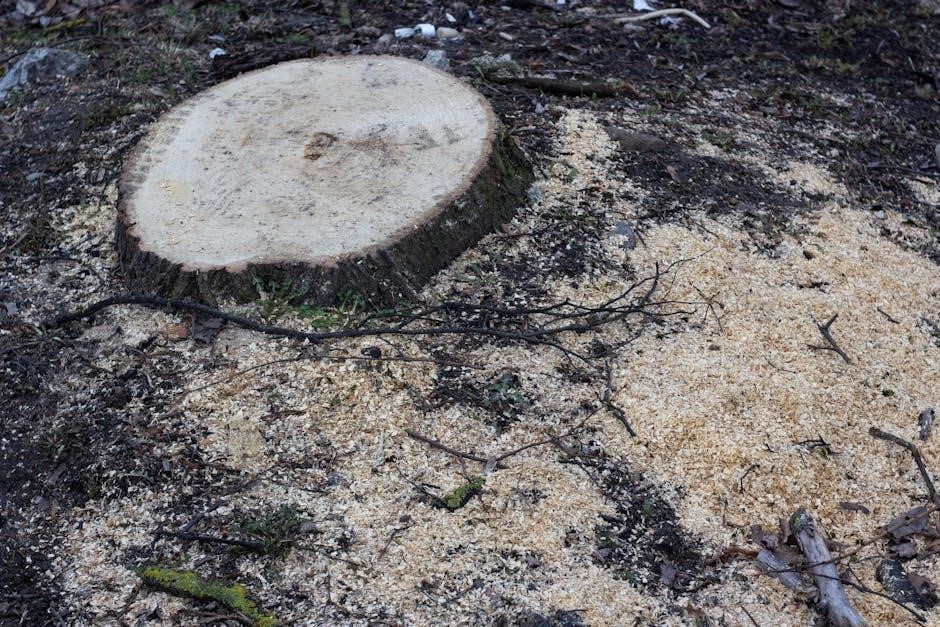Earth’s Structure and Plate Tectonics
The Earth’s structure includes the crust‚ mantle‚ outer core‚ and inner core․ Plate tectonics involves the movement of lithospheric plates‚ driving geological processes like earthquakes and volcanic activity․
Key Points:
- Plates move at convergent‚ divergent‚ and transform boundaries․
- Geological features form through these interactions‚ shaping landscapes over time․
1․1 Earth’s Layers
The Earth is composed of distinct layers: the crust‚ mantle‚ outer core‚ and inner core․ The crust is the outermost layer‚ varying in thickness and composition․ Beneath it lies the mantle‚ divided into the upper and lower mantle‚ made of hot‚ viscous rock․ The outer core is a liquid layer of iron and nickel‚ generating Earth’s magnetic field․ The inner core is a solid‚ iron-nickel alloy at extreme temperatures and pressures․ These layers interact to shape Earth’s surface and geological processes‚ essential for understanding plate tectonics and Earth’s internal dynamics․
1․2 Plate Boundaries and Geological Processes
Plate boundaries are areas where tectonic plates interact‚ driving geological processes․ At divergent boundaries‚ plates move apart‚ producing new crust through processes like seafloor spreading․ Convergent boundaries involve plates colliding‚ leading to subduction or mountain formation․ Transform boundaries occur where plates slide past each other‚ causing earthquakes․ These interactions shape Earth’s surface‚ creating features like volcanoes‚ trenches‚ and fault lines․ Understanding these processes is crucial for studying earthquakes‚ volcanic activity‚ and the Earth’s dynamic surface․ Plate movement is slow but continuous‚ reshaping landscapes over millions of years and influencing Earth’s geological history and ecosystems․ This knowledge is foundational for environmental science and resource management․
1․3 Earth’s Geologic Cycle
The Earth’s geologic cycle refers to the continuous processes that shape the planet’s surface and interior․ It includes the formation‚ transformation‚ and recycling of rocks․ Igneous‚ sedimentary‚ and metamorphic rocks undergo changes through processes like magma cooling‚ sedimentation‚ and high-pressure transformations․ Weathering and erosion break down rocks‚ while plate tectonics drives the creation of mountain ranges and volcanoes․ The cycle also involves the movement of materials between Earth’s layers‚ such as the lithosphere‚ asthenosphere‚ and core․ Understanding this cycle helps explain geological events‚ resource formation‚ and the Earth’s dynamic nature over millions of years․ It is a key concept in environmental science for studying Earth’s systems․

Atmosphere‚ Hydrosphere‚ and Biosphere
The atmosphere is Earth’s gaseous layer‚ regulating climate․ The hydrosphere includes water systems‚ essential for life․ The biosphere is where life exists‚ interacting with the other spheres․
2․1 Composition of the Atmosphere
The atmosphere is primarily composed of nitrogen (78%) and oxygen (21%)‚ with trace amounts of gases like argon‚ carbon dioxide‚ and water vapor․ These gases play crucial roles in supporting life and regulating Earth’s climate․
- Nitrogen and Oxygen: Essential for respiration and plant growth․
- Carbon Dioxide: A greenhouse gas influencing the carbon cycle․
- Water Vapor: Drives weather patterns and precipitation․
Understanding atmospheric composition is vital for addressing environmental issues like climate change and air quality․
2․2 The Greenhouse Effect and Climate
The greenhouse effect is a natural process where atmospheric gases trap heat‚ maintaining Earth’s temperature․ Key greenhouse gases include carbon dioxide‚ methane‚ and water vapor․ Human activities‚ such as fossil fuel combustion and deforestation‚ amplify this effect‚ leading to global warming and climate change impacts like rising temperatures‚ extreme weather events‚ and melting ice caps․ This disrupts ecosystems and necessitates understanding for effective environmental policies․
- Carbon Dioxide: Released through burning fossil fuels and deforestation․
- Methane: Emitted from agriculture and natural gas systems․
- Water Vapor: Influenced by evaporation and atmospheric conditions․
Addressing these factors is crucial for mitigating climate change and protecting biodiversity․
2․3 The Carbon Cycle
The carbon cycle describes the movement of carbon between Earth’s atmosphere‚ biosphere‚ oceans‚ and soil․ Carbon dioxide is released through processes like respiration‚ decomposition‚ and human activities‚ while it’s absorbed by plants during photosynthesis․ Oceans absorb and store carbon‚ contributing to the global carbon sink․ Human activities‚ such as burning fossil fuels‚ disrupt this balance‚ leading to increased atmospheric CO2 levels․ Understanding this cycle is essential for addressing climate change․
- Carbon Sources: Fossil fuels‚ deforestation‚ and respiration․
- Carbon Sinks: Forests‚ oceans‚ and soil․
Managing carbon flux is critical for maintaining ecological balance and mitigating global warming impacts․

Soil Formation and Resources
Soil forms through weathering‚ organic matter decomposition‚ and time‚ composed of minerals‚ water‚ air‚ and organic material‚ serving as a vital resource for ecosystems and agriculture‚ essential for plant growth and sustaining life․
3․1 Soil Formation Processes
Soil formation begins with parent material‚ such as rocks or sediments‚ undergoing weathering processes․ Physical weathering breaks rocks into smaller particles‚ while chemical weathering alters mineral composition․ Organic matter from decomposed plants and animals enriches the soil‚ improving its structure and fertility․ Over time‚ these components mix with water‚ air‚ and living organisms‚ forming distinct soil horizons․ Climate‚ topography‚ and biological activity influence the rate and type of soil development‚ creating diverse soil profiles that support various ecosystems․ This gradual process can take centuries‚ making soil a vital yet finite natural resource․
3․2 Soil Composition and Erosion
Soil is composed of 45-50% mineral particles (sand‚ silt‚ clay)‚ 20-50% water‚ 2-10% organic matter‚ and 1-5% air․ The texture and structure determine water retention‚ aeration‚ and nutrient availability․ Erosion occurs when soil is stripped away by wind or water‚ often due to deforestation‚ overgrazing‚ or improper farming practices․ Topsoil‚ the most fertile layer‚ is particularly vulnerable․ Soil conservation methods like terracing‚ contour plowing‚ and afforestation help mitigate erosion․ Understanding soil composition and erosion mechanisms is critical for sustainable land management and maintaining agricultural productivity․ Soil health directly impacts ecosystems and human livelihoods‚ making it a key focus in environmental science․
3․3 Importance of Soil in Ecosystems
Soil is vital for ecosystems as it supports plant growth‚ stores carbon‚ and filters water․ It provides nutrients and habitat for organisms‚ enhancing biodiversity․ Soil’s role in the carbon cycle helps mitigate climate change by storing CO2․ It also filters water‚ improving quality and reducing pollution․ Healthy soils sustain agricultural productivity‚ ensuring food security․ Erosion prevention and nutrient cycling are critical for maintaining ecosystem balance․ Soil conservation practices are essential for long-term environmental sustainability and human well-being․ Understanding soil’s importance highlights the need for sustainable land management to preserve ecosystem services and support life on Earth․ Soil is a cornerstone of environmental health and resilience․

Earth’s Resources
Earth’s resources include renewable and non-renewable materials essential for life and economic activities․ They support ecosystems‚ energy production‚ and human needs‚ requiring sustainable management to ensure availability for future generations․
4․1 Renewable vs․ Non-Renewable Resources
Renewable resources‚ like solar‚ wind‚ and water‚ naturally replenish over time‚ making them sustainable․ Non-renewable resources‚ such as fossil fuels and minerals‚ are finite and take millions of years to form․
- Renewable: Resources that regenerate naturally within human lifetimes (e․g․‚ biomass‚ hydropower)․
- Non-Renewable: Resources depleted faster than they form (e․g․‚ coal‚ oil‚ natural gas)․
Understanding their differences is key to managing Earth’s resources sustainably and addressing environmental challenges․
4․2 Resource Management and Sustainability
Resource management involves strategies to balance human needs with ecological preservation․ Sustainability ensures resources are used without depleting them for future generations․
- Renewable resources must be harvested at rates matching natural replenishment (e․g․‚ forests‚ fisheries)․
- Non-renewable resources require careful extraction to minimize environmental impact․
- Sustainable practices include conservation‚ recycling‚ and efficient technologies․
Effective management integrates policies‚ regulations‚ and incentives to promote resource stewardship and mitigate environmental degradation․
4․3 Case Studies in Resource Management
Case studies highlight effective and ineffective strategies in resource management․ Successful examples include sustainable forest management in the Pacific Northwest‚ balancing logging with ecosystem preservation․ Conversely‚ the collapse of the Newfoundland cod fishery illustrates overexploitation leading to ecological and economic disaster․
- Best practices often involve adaptive management and stakeholder collaboration‚ as seen in Australian water reforms․
- Challenges arise when policies neglect long-term sustainability‚ such as the Aral Sea disaster due to excessive irrigation․
These studies emphasize the importance of integrating scientific research‚ policy‚ and community engagement to achieve sustainable resource use‚ ensuring both human and environmental well-being․

Scientific Practices and Experiments
Scientific practices involve field observations‚ laboratory experiments‚ and data analysis․ Researchers use statistical methods‚ modeling software‚ and experimental designs to study Earth’s systems and test hypotheses effectively․
- Fieldwork includes sampling and monitoring environmental conditions․
- Laboratory analysis processes data for accurate interpretations․
- Experiments simulate real-world scenarios to predict outcomes․
5․1 Methods in Earth Systems Research
Earth systems research employs various methods‚ including field observations‚ laboratory experiments‚ and data analysis․ Fieldwork involves sampling and monitoring environmental conditions‚ while lab analysis processes data for accurate interpretations․ Remote sensing and GIS tools are used to study large-scale patterns․ Statistical methods and modeling software help predict outcomes and test hypotheses․ Experimental designs simulate real-world scenarios to understand complex interactions․ Researchers also conduct literature reviews and collaborate across disciplines to integrate findings․ These methods provide a comprehensive understanding of Earth’s systems‚ enabling scientists to address environmental challenges effectively․ By combining these approaches‚ researchers can develop robust models and solutions for sustainable resource management and ecological conservation․
5․2 Data Analysis and Interpretation
Data analysis and interpretation are critical in Earth systems research․ Scientists use statistical methods‚ graphical tools‚ and software like Excel or R to process data․ Techniques include regression analysis‚ trend identification‚ and hypothesis testing․ Data visualization‚ such as graphs and maps‚ helps communicate findings effectively․ Interpreting data involves drawing meaningful conclusions and identifying patterns․ For example‚ analyzing climate data reveals temperature trends‚ while soil data analysis informs nutrient cycling․ Accurate interpretation is essential for forming evidence-based environmental policies and management strategies; By combining data from diverse sources‚ researchers can address complex questions about Earth’s systems and their interactions‚ ensuring informed decision-making for sustainability and resource management․
5․3 Practical Applications of Earth Science
Earth science has numerous practical applications that address real-world challenges․ Understanding Earth’s systems helps manage natural resources‚ predict hazards like earthquakes and volcanic eruptions‚ and develop sustainable practices․ Geological knowledge aids in mineral exploration‚ soil conservation‚ and water resource management․ Additionally‚ Earth science informs climate change mitigation strategies and environmental policies․ Technologies like GIS and remote sensing are essential tools for monitoring and analyzing Earth’s systems․ These applications contribute to improving human life‚ environmental sustainability‚ and economic development․ By applying Earth science principles‚ we can better prepare for natural disasters and ensure responsible use of Earth’s resources for future generations․



